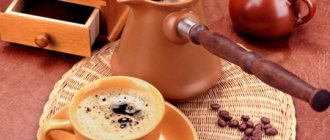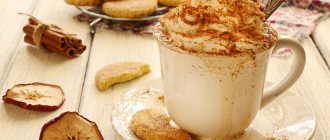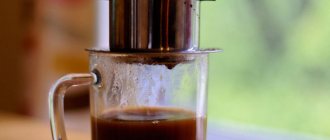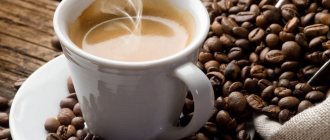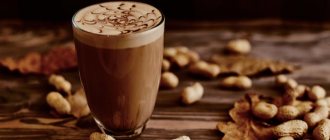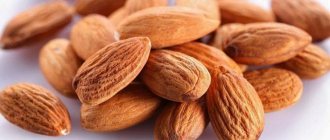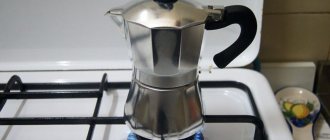The emergence of coffee macchiato: history and legend
In the thirties of the twentieth century, coffee macchiato became a famous fashionable drink. In Italy, this coincided with the popularity of espresso, which in coffee culture is usually drunk during the day. However, some Italians ordered this coffee with milk foam.
The difficulty was that milk and espresso are the basis of several drinks. By varying the ratio, sequence and technique of adding ingredients, completely different coffee cocktails are obtained.
As often happens, a brilliant recipe appeared due to chance. Perhaps the barista was inexperienced, or the customer was unable to convey his point. But the result managed to win the hearts of a significant part of coffee fans.
There is a legend that an Italian looked at the drink and said in surprise “macchiato?” And now, to make it easier for customers to explain things to the barista, they use this name. Indeed, specks of golden foam clearly stand out on the smooth surface of the drink.
The name macchiato is also found in other coffee and milk drinks, although the process and recipe are different from the classic Italian one. For example, latte macchiato. Since the nineties of the last century, the Starbucks chain has had a similar technique for creating a “caramel macchiato” milkshake. This further confused the situation.
Even children can drink European macchiato with a ratio of 1:1.5.
Because of such nuances, most of the recipes available on the global network refer to latte macchiato. And only an Italian barista will prepare a traditional drink. In other parts of the world, it is better to order an espresso macchiato to avoid mistakes.
Many people consider cappuccino a more feminine drink. But it has such a “charge” of caffeine that this coffee is more likely to have a masculine character. However, this only applies to the Italian classic version.
The history of the drink and how it differs from cappuccino
Difference between types of coffee with milk
Macchiato appeared in the 30s of the 20th century in Italy, where Illy brand coffee came to us, where another drink, espresso, was just gaining momentum.
There is a legend that a visitor to one of the coffee shops allegedly ordered coffee with milk, but specified that he wanted something special. To please the client, the barista frothed warm milk and added espresso to it.
The difference between this drink and cappuccino is not big. Macchiato differs in the amount of milk - one part of frothed milk is added to one part of esperso.
Because of its unusual appearance, macchiato quickly became a fashionable drink, and it is appreciated both by the fair sex for its delicate taste and by the male half of humanity for its sufficient strength.
Coffee macchiato and coffee cocktails: differences
Despite the similarity in ingredients, cappuccino, latte and latte macchiato are easy to distinguish from classic Italian. You don't have to have barista experience to know:
- there is significantly less milk in a macchiato than in other coffee-milkshakes;
- the appearance and consistency of the drink largely depend on the preparation technique, therefore, to obtain a real macchiato, milk foam is added to the coffee;
- the traditional drink is made only on the basis of espresso;
- Macchiato is served not in heat-resistant Irish glasses, but in ceramic cups.
The last point may seem insignificant, but it is the correct serving that allows you to fully enjoy the benefits of each type of coffee. Italians believe that the transparent walls of a glass can affect the taste of coffee.
Varieties
There are several subtypes of coffee macchiato, and the name depends on the temperature at which the milk is used. If it is cold, the drink is called “Macchiato Fredo”, and if it is hot, then “Macchiato Caldo (Caldo)”.
It is quite common to add various syrups, liqueurs and cocoa to improve the taste. By adding caramel (usually caramel syrup is the first bottom layer), you can get a delicious caramel macchiato.
A classically prepared macchiato is called “Espresso macchiato”, and “Latte macchiato” is a regular latte, only with a modified technology for mixing ingredients. First, pour out the milk, and only then the coffee, so that a characteristic scattering of coffee stains forms on the surface. In this case, there is no need to apply foam on top.
Coffee macchiato recipe
Macchiato has its own characteristics: a pleasant balanced taste, brown and golden color, strength with a small volume and thick porous foam.
To achieve a lush crema in espresso, it should be brewed from a mixture of Arabica and Robusta. Approximately 9:1. Robusta imparts bitterness, so too much of it will make the coffee too bitter. In extreme cases, the reputation of the macchiato will not suffer much if you take only Arabica.
Freshly ground coffee is preferable to a fine or slightly finer grind. Dark roasts don't go well with milky flavors. Medium roasts work best.
Coffee brewed with city water will taste worse than when using purified water, due to chlorine. You can try to purify it by filtration, but bottled or spring water with a mineralization of about 150 mg/l is preferable.
In order for milk to whip into a thick foam more easily, it must be fat (at least 3.2%). Baked milk gives the finished drink an interesting, unusual taste. For those watching their weight and figure, it is better not to add sugar than to replace good milk with skim milk. The loss in taste and appearance of the macchiato is not worth those 1.5-4 calories. Whereas a serving of sugar of five grams will add more than nineteen.
How to make macchiato at home
Without resorting to the services of professional baristas, you can easily brew coffee macchiato at home. When preparing a drink, it is better that you do not have to rush anywhere. The coffee drink requires precision in proportions and accuracy in the preparation process. Cooking time is about 20-25 minutes.
What ingredients will be needed:
- Natural ground coffee - 2-3 tsp. It is better to use coffee beans and grind it yourself. If you don’t have it, then choose the finest ground coffee. The taste of the drink will depend on this.
- Milk with 6% fat content - 100-150 ml. You can also have less fat if you prefer.
- Sugar to taste. Recommended 2-3 tsp.
How to cook:
- Take a small container (pan), pour in 100-150 ml of milk. Place on low heat.
- Heat the milk to about 70-80 degrees. Make sure that no foam forms on the milk.
- Add sugar to heated milk. Mix well.
- Pour 2-3 tsp of ground coffee into the Turk. and add cold water. Place the Turk over low heat and bring almost to a boil. At the same time, make sure that the coffee foam does not have time to rise.
- Remove the coffee from the heat and let it sit for a while so that the grounds settle to the bottom of the pot.
- Let's return to milk. Start whisking the heated milk using a blender or whisk for 2-3 minutes. The result should be thick, frothed milk.
- Pour the milk into a glass, leaving a couple of spoons of milk foam to decorate the coffee.
- Carefully pour the prepared espresso into the “foamy” milk. Take your time. The layers should not mix.
- Top the drink with foam. Coffee macchiato is ready.
Characteristics of a macchiato
When using a coffee machine, you must adhere to the following parameters and characteristics:
- pure Arabica or mixed with a fifth of fine or medium-ground Robusta, “full city” or “Viennese” roast;
- pressure in the chamber is not less than 9, pump pressure is not less than 15 bar;
- the coffee temperature at the outlet is about 88, in the cup about 67 degrees;
- chilled milk +4, after whipping +60;
- ready macchiato +64.
It takes three to five minutes to create the drink. A 65 ml serving (with foam) can contain up to 70 mg of caffeine, which determines its strength. Therefore, even avid coffee drinkers are not recommended to consume more than 6-7 such cups per day.
For “ordinary” people, one or two cups a day is enough. In addition, a serving of macchiato is about 11 kcal. And with the addition of one stick of sugar - up to 30.
How to serve and drink
Macchiato is usually served in a tall glass goblet with a heat-resistant glass handle. This will allow you to demonstrate the main quality of the drink - three-layered. It is served to the table immediately after preparation.
There are many debates that arise based on the correct use of macchiato. Some believe that the cocktail should be stirred before drinking, while others should drink it in layers. It is worth considering that it is possible both ways. When stirred, its taste will be softer and milkier. If you drink the cocktail in layers, you can feel the taste of each part. To do this, such coffee is served with a straw. To taste the taste of milk foam, macchiato is often served with an elongated spoon.
Frothing milk. Features for macchiato
It is easier to froth milk to a uniform consistency if you take it chilled. Pasteurized is ideal. It is more convenient to do this with a cappuccino maker.
To do this, immerse the cappuccino maker nozzle half a centimeter into the pitcher with milk. During the whipping process, the foam will increase in volume, so you need to gradually lower the jug so that the nozzle remains at the original level from the surface.
When the foam is three centimeters from the edge, the steam generator must be lowered to the bottom. When the milk reaches 60 degrees, the whipping process is over. Next, you need to compress the foam by gently tapping the bottom on the table several times. By rotating the pincher, we separate the foam from the milk.
Creation Story
This coffee drink began its march around the world from Italy, and after some time it amazed the whole world with its extraordinary taste and appearance. But why such a strange title? Macchiato - what is it anyway?
Macchiato is an Italian word that translates to “spotted” or “marked.” This name came out for a reason, because the drink actually looks like it has spots, its coffee chains (layers) are clearly visible.
This look is achieved thanks to a special technique of mixing milk and coffee. In an ordinary traditional recipe, milk is added to the already prepared coffee, but in the macchiato coffee recipe it’s the opposite. First, the prepared frothed milk is poured into the cup, and only then the coffee itself. And it turns out that the coffee seems to be drowning in foam and leaving spotty traces behind it.
If the macchiato is prepared correctly, it will have a layered structure: there will be milk on the bottom tier, coffee in the middle, and foam at the very top. The borders are very smooth with a beautiful transitional gradient.
To make this coffee drink, the same composition is always used, but each cafe has its own personal hidden recipe.
Classic macchiato, recipe and preparation
To create a traditional drink you need the following ingredients:
- ready-made espresso, brewed from 7 grams of freshly ground beans (approximately 30 ml);
- cooled to +4 fat milk 15 ml;
- topping to taste.
Ground cinnamon, caramel, vanilla syrup, and chocolate chips are usually used as topping. Gourmets add liqueur and other various syrups to this list (except citrus fruits, which cause milk to curdle).
By the way, “espresso” for an Italian is just a technical term for properly brewed coffee. Freshly roasted, freshly ground grains are especially appreciated.
Cooking technique
Whisk, bring the milk component to sixty degrees. Heat the cup and pour fresh espresso into it. Slowly add the frothed milk in a gentle stream. Granulated sugar optional. Chocolate decor or cocoa is placed on the foam.
You can use the syrup to draw lines on the foam, and then use a toothpick to complete the drawing. This is latte art.
Espresso macchiato with hot milk is also called “macchiato caldo”. A drink with a double dose of coffee is doppio. The process is similar to the classic one.
If necessary, milk can be replaced with a plant equivalent (for example, coconut milk).
Preparation
For tasty and beautiful “spotted” coffee, the process of combining ingredients is important. The espresso is carefully poured into the frothed warm milk, even using the blade of a knife. It is necessary that the dark layer is located under the foam. If done correctly, the liquids will mix only slightly.
Coffee will take the right place in the glass due to the difference in density and temperature of the ingredients. The result will be a three-layer cocktail with gradient transitions, and one dark spot will remain on the white surface. Baristas can create a dark pattern on milk foam by masterfully combining ingredients.
Basic recipe
You will need:
- 7-10 g ground coffee;
- 60 ml water;
- 100 ml milk with 3.2% fat content.
Prepare espresso in a coffee maker or coffee machine.
If you cook in a Turk, the density of the liquid will be less and it will be difficult to achieve a layered structure. In addition, such coffee will need to be strained so that the grounds do not spoil the lower milk layer.
Whisk the milk, gradually heating it to 60-70 °C. A thick foam should form on top. The easiest way to do this is with a cappuccino maker, but you can use a blender or French press. Pour the prepared milk into a tall transparent glass. Then pour in the hot espresso in a thin stream, trying to get it between the milk and the foam. The finished cocktail can be sprinkled with grated chocolate or cinnamon.
For those with a sweet tooth, you can use a little sugar, but you need to add it to hot espresso before combining it with milk.
With syrup
The recipe differs only in the addition of a bottom layer. First of all, pour 2 tablespoons of syrup into a glass. Another spoon can be added when whipping milk foam. Vanilla, chocolate or any berry topping will work. The cocktail will be four-layer, sweet and higher in calories.
Caramel
The taste of caramel goes well with milk and coffee. Beat 1-2 tablespoons of homemade caramel or ready-made syrup with milk. The foam is decorated by pouring caramel in a thin stream.
A latte macchiato recipe can include chocolate, cocoa or cinnamon as a garnish.
Types of macchiato
This coffee and milk drink can be not only invigorating and warming. Some of its types cope well with the role of a refreshing cocktail or dessert. Each barista has his own secrets for creating a macchiato, adding to its uniqueness. However, traditional recipes and methods are publicly available.
Macchiato Fredo
Fredo's coffee drink is prepared with cold milk. Italians consume it during the hot season.
The recipe is simple: espresso and milk are served separately. The visitor himself drinks the required amount of milk from a small ceramic jug.
Ristretto Macchiato
Ristretto is a very strong espresso. For the same amount of water, take a double portion of coffee. For this type of macchiato you will need:
- 30 ml ristretto;
- 15 ml milk.
Coffee with a speck
Macchiato means "spotted" in Italian. Dark coffee stains appear on the white milk foam. The Italians, passionate about coffee, tried to make its taste more delicate and reduce the caffeine content. The name of the cocktail (“spotted milk”) indicates the main component.
The recipe was liked by those for whom strong coffee drinks are not recommended for health reasons. The impressive-looking drink in clear glasses began to be prepared and served in Starbucks coffee shops in 1989. It is especially loved by the fair sex in Europe for its delicate creamy taste and low calorie content.
Traditions of serving and drinking espresso macchiato
Classic Macchiato is usually served in traditional ceramic cups. The exception is the caramel version and macchiato with a layered structure.
Although the taste of this coffee is delicate and does not need additional sweetening, a sugar bowl (or stickers) and a spoon (sometimes a straw) are served along with the cup. The foam is decorated with art latte. Or drawings with cinnamon (cocoa), using artistic talent or a stencil.
When adding sugar, the espresso macchiato can be gently stirred with a spoon in a slow circular motion so as not to spoil the foam.
A cup of this coffee is drunk in different ways: in a few sips or after eating the foam.
In Italy, attitudes towards traditions have been elevated to almost a cult. Coffee was no exception. In a country where it is made and drunk at every turn, there are a lot of rules and conventions associated with this drink. Incomprehensible, funny and with deep meaning, they have become one of the colorful features of Italian coffee culture.
Espresso macchiato is closer to desserts, so it goes better with chocolate, fruit and cheese. Meat and fish are not served with it.
Italians traditionally drink macchiato and latte macchiato from the morning until 11 o'clock in the afternoon, between breakfast and lunch. A drink ordered at an inopportune hour confuses Italian connoisseurs of coffee traditions.
It is even customary to apologize to the waiter when making such an order. However, the fair half is “allowed” to drink this coffee at any time. But it’s better not to do this on an empty stomach. Optimally, an hour and a half after eating. In this case, breakfast.
Italians also believe that morning coffee should be drunk while standing, classifying it as a digestif (drinks that improve digestion). There are even bars that charge a premium on the drink consumed at the table.
“Large” doses are not popular on the Apennine Peninsula. Here they prefer to order two servings of coffee.
Properties and Features
Macchiato can be distinguished by several features. When prepared correctly, it will separate into 3 parts: milk will be in the bottom, espresso will occupy the middle, and foam will rise to the top. In this case, macchiato will not have clear boundaries - all colors are mixed and blurred upon contact.
Interestingly, the taste of espresso macchiato can be conveyed in different ways. This depends on the proportional features of cocktail preparation adopted in certain countries or coffee shops.
- Australian baristas prepare coffee based on 1 to 1 proportions. Its taste is distinguished by its delicateness.
- In Europe, it is customary to brew macchiato using 1 part espresso and 1.5 parts milk. This product is very tender and has a creamy taste.
- In Italy, this coffee is most often prepared from a double portion of espresso and 1 part milk. This recipe allows you to increase the strength.
But all of the countries listed follow the method of preparing this coffee cocktail, which is why it has a three-layer structure.
